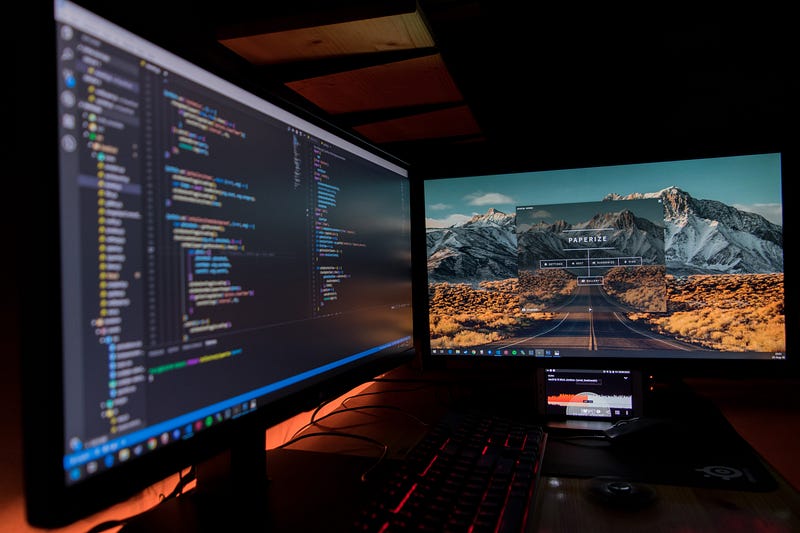Exploring Life Without Computers: A Journey Through Technology
Written on
The Evolution of Computing
How dependent are we on technology? Imagining life without computers prompts a reflection on our reliance on these devices.

The Historical Context of Computers
In the United States, computers have transitioned from enormous, expensive machines, once costing hundreds of thousands of dollars, to the compact devices we use today. These early models necessitated entire teams of engineers for their upkeep. Despite their impressive capabilities, they required strict climate control and were physically daunting to approach.
While enthusiasts could construct smaller machines, they were mostly limited to basic math functions and simple games—far from the versatility we enjoy today with personal computers. Before the late 1970s, it was rare to find a laptop or desktop computer in offices or homes.
The Birth of Computers
Computers first made their mark in American society during World War II, with the University of Pennsylvania's creation of the Electronic Numerical Integrator and Computer (ENIAC). This groundbreaking system was designed for ballistic calculations, costing around $500,000, weighing 30 tons, and occupying 2,000 square feet. Its exterior was a chaotic array of wires, blinking lights, and around 6,000 mechanical switches, while its interior housed 18,000 vacuum tubes that transmitted electrical signals.
Advancements in Technology
In 1948, Bell Labs unveiled the transistor, a smaller alternative to the vacuum tube that could amplify electrical signals. By 1958, scientists at Texas Instruments and Fairchild Semiconductor developed the integrated circuit, which consolidated all electronic components onto a single silicon chip. The introduction of the microprocessor was a pivotal moment in computing history, allowing for greater functionality within a compact size. Intel engineer Ted Hoff created the first microprocessor, which measured just 1/16 by 1/8 inch yet rivaled the capabilities of the ENIAC.
The Dawn of Personal Computing
The personal computer emerged in 1974 with the Altair, a build-it-yourself kit from Micro Instrumentation and Telemetry Systems (MITS), which gained immense popularity despite its lack of a keyboard or screen—users interacted through toggle switches and lights. In 1975, MITS hired two Harvard students, Paul Allen and Bill Gates, to develop the BASIC programming language for the Altair, leading to the formation of Microsoft.
Meanwhile, in 1976, Steve Jobs and Paul Wozniak created the Apple 1, a more advanced machine than the Altair, featuring a monitor and enhanced memory. Their 1977 release of the Apple II included a keyboard and color display, paving the way for data storage on floppy disks.
The PC Revolution
The PC revolution ignited with the entry of companies like Xerox, Tandy, Commodore, and IBM into the market, making computers commonplace in both businesses and homes. The advent of graphical user interfaces and the computer mouse made PCs increasingly user-friendly.
Computer Industry Landscape
Today, major companies like Lenovo, HP, Dell, Apple, Acer, and ASUS dominate the global PC market, accounting for over 81% of shipments. Key drivers for this market include:
- Increased internet usage
- Rising income levels
- Expanded computer education
- Growing urbanization and evolving consumer lifestyles
However, the shift towards tablets and smartphones for tasks like email, social media, and online shopping poses challenges for the PC market.
The Future of Computing
What does the future hold? The rise of ultraportable laptops and all-in-one PCs with touchscreens is reshaping how users manage information. Major companies are pivoting towards software and gaming, with Dell focusing on enterprise software and cloud solutions, while HP emphasizes gaming ecosystems.
What If I Lived Without a Computer?
Reflecting on a life devoid of computers, I realize that while it would pose significant challenges, I could adapt. Communication would regress to slower methods, and my writing would revert to pen and paper. Research would become cumbersome, and I would miss the convenience of digital organization.
Yet, the absence of a computer wouldn't thwart my success. I could revert to reading physical books and maintain a paper calendar to manage my schedule. Despite the difficulties, I believe I could navigate life without a computer, though I sincerely hope such a scenario does not materialize. Many people today are so accustomed to digital living that adjusting to a computer-less existence would be particularly arduous for them.
The first video, "Living Without Technology: Computers," explores the implications of a life without modern technology, discussing the potential challenges and adaptations required.
The second video, "My Life Without Technology," shares personal stories and insights on how individuals navigate life in a world increasingly dominated by technology.